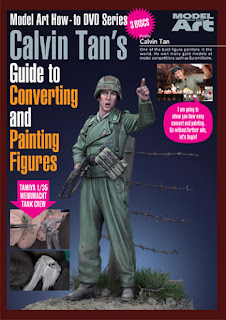Young Miniatures - Fallschirmjäger, FJR 9, Ardennes, 1944
.
I've decided to once again indulge myself with a recreational project compliments from Young Bok, proprietor and principal sculptor of Young Miniatures. Consisting of only five parts, clean-up and assembly took under an hour before it was christen with a veil of grey primer.
Continuing from the previous project of the MG-34 machine gunner bust, I interfaced each connecting part with magnets for easy handling during painting. This was achieved by drilling out a shallow cavity to accommodate the piece of magnet. Epoxy putty was used to both adhere and maneuver the magnet into alignment with its corresponding half. I got to admit that this eventually proved quite fun when I toyed with the parts as they "clicked" together.
Moving on to the painting, I employed a traditional approach used in classical painting known as painting on colored grounds.
"A toned ground can be used to create atmosphere or mood, to unify a composition, indicate lighting conditions, or to give sculptural form to an object by giving depth to shadows. A toned ground speeds the process of painting, allowing simpler modelling and killing the stark white that otherwise would confront the artist initially." Colour and Tone in Whistler's 'Nocturnes' and 'Harmonies' 1871-72" by Stephen Hackney. The Burlington Magazine Vol 136, No 1099 (Oct 1994), pp695-694.
As such red,blue,violet and orange were initially sprayed over a black undercoat before assigning the local colors.
I also tried to experiment with a "Wet on Wet" diffusion technique, similar to that used in watercolor painting. As this required a homogeneously damp surface in order for the different colors to mingle, water was sprayed over the surface with an airbrush before dabbing on the colors immediately after.
Complimentary colors for the face were subsequently introduced for added tonal variety and contrast.
The various stages to painting the face; from the blocking of tonal colors to the gradual refinements. As I do not have a linear work flow, this area will still be subjected to additions and changes as with the progress of the project.
The shovel was undercoated with gloss varnish before dry-brushing with silver enamel paint.
It was then painted over with an opaque coat of dark blue and allowed to dry.
A light mist of water from the airbrush provided the moist surface which allowed the dabs of orange to be randomly diffused across the shovel blade.
Effects of wear are simulated by carefully chafing the paint with a hard metal tool.
Progressive painting for the camouflage jump suit and accompanying accessories.
That's the work for now until opportunities at home allows.
Calvin








































